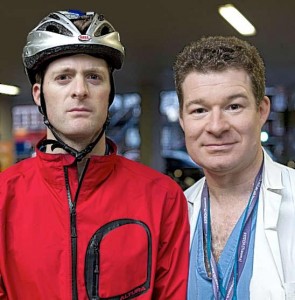Two practices trauma surgeons have written a joint letter to the Evening Standard to highlight the need for action on cycle deaths.
 As practicing trauma surgeons, working in two of London’s Major Trauma Centres, we regularly see the effects of injuries from trauma. Both of us also work in the pre hospital arena for the London Air Ambulance and look after patients at the scene where they have suffered their injuries.
As practicing trauma surgeons, working in two of London’s Major Trauma Centres, we regularly see the effects of injuries from trauma. Both of us also work in the pre hospital arena for the London Air Ambulance and look after patients at the scene where they have suffered their injuries.
1 million Londoners have bikes and bicycle journeys account for 2% of journeys in London (37% in Amsterdam). Between 1999 and 2011, 1575 cyclists have been killed in Great Britain. There have been 16 cyclist deaths this year in London alone. This is similar to the number of teenagers stabbed to death this year. This is in keeping with previous years despite an increase in the number of cycling journeys. For all those killed there are a larger number who suffer non life threatening injuries. These are not excuses and each death or seriously injured person is one too many.
As doctors in the capital, we believe that injuries to cyclists are a public health issue that needs urgent attention. Trauma care in London has made huge advances in the way the severely injured are cared for. This may improve the mortality figures and morbidity from cycling injuries but prevention remains are far better strategy than cure. The recent deaths on the Bow roundabout and near Tower Bridge and the crash involving a female Times journalist in Wapping have reignited the argument about the provision of safe roads for cyclists and drivers.
As practicing trauma surgeons in two of the capitals major trauma centres we see the people who have suffered injuries while cycling. We also deal with patients at the roadside when working for the London Air Ambulance. One of the immediate dispatch criteria for the aircraft or fast response car is when someone is trapped under a vehicle. This scenario all too frequently occurs when cyclists are trapped under a vehicle that has turned in front and then driven over them. These patients are often young women, travelling to or from work and are caught under the wheels of vehicles turning in front of them.
A report by TFL in 2008 found that 86% of cyclist deaths were female despite there being three times as many male cyclists as females. At the scene of a road traffic collision, the team are often asked by the police if the injuries are deemed to be ‘life threatening of life changing’. The experience of being involved in a road traffic crash is life changing for all involved. Some will never cycle again for fear of suffering further injuries. This may be a manifestation of PTSD. Some people do not survive to make a choice.
Their mechanisms of injury include devastating chest injuries (rib fractures and underlying lung injury), abdominal injuries (splenic injuries and bowel injuries) and pelvic fractures and leg fractures. These patients are often initially conscious but are in danger of quickly bleeding to death on the roadside. The London Ambulance Service and Air Ambulance response is geared towards timely recognition and delivery of roadside intensive care. Patients may be given a general anaesthetic to help them breath, their pelvic fracture and limb fractures are splinted to reduce blood loss and they are given drugs to promote blood clotting.
These patients are the most challenging on scene and result in an augmented response from the receiving hospital. If they survive their first day they are still at risk from overwhelming infection and organ failure. Their hospital stay is a long one and they may never return to their pre morbid state and may never work again.
These patients are sometimes deemed to be those who ‘talk and die’. They are initially conscious and able to talk to you and tell you their fears and tell you of their pain. One of the on scene standard operating procedures includes giving them a general anaesthetic. This is done to ease their pain and suffering for humanitarian reasons, assist with breathing, expedite their transfer from scene and speed up their time to definitive care. One always remembers these patients, when we are the last ones they ever speak to.
Both of us are cyclists, covering thousands of miles a year. We are both aware of the obvious health benefits of cycling to the individual and also benefits for the community and the environment as a whole. We believe that there are inherent dangers when cyclists and heavy goods vehicles share road space. There are also dangers when cyclists are encouraged to use green feeder lanes that place them between a vehicle turning left and a metal barrier and there should be penalties for those that block bicycle lanes.
The cycle scheme lanes are a step in the right direction but should not be limited to those areas between docking stations but should be extended to other routes. We believe that more needs to be done to educate cyclists, drivers, road designers and those in government who are charged to lead and protect us to do more to prevent injuries amongst cyclists.
Mr Thomas König MRCS and Mr Mark Wilson FRCS
Trauma Surgeons
London Trauma Network



0 Comments
You can be the first one to leave a comment.